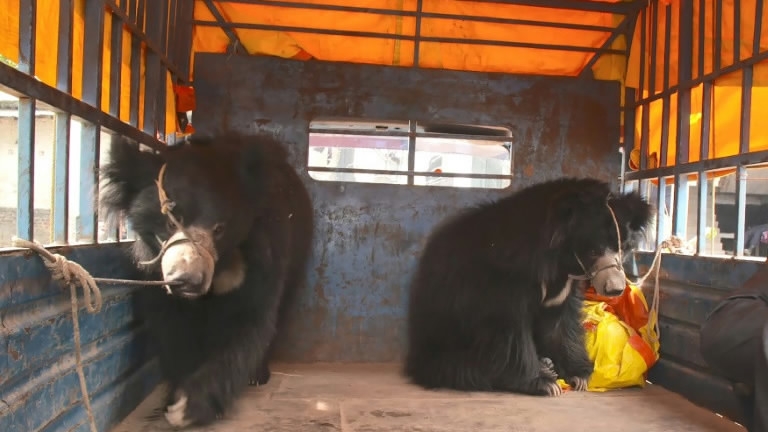
animal
17:24, 26-Dec-2017
Nepal's last two dancing bears rescued

Nepali officials said on Sunday that authorities have rescued the country's last known "dancing bears", in a major step towards ending the tradition of animal abuse being committed for entertainment.
The Himalayan nation banned the practice of performing bears back in 1973 but the tradition, an occupation for some street performer communities, lingered on in parts of its southern region.
Police and animal charities said they spent more than a year hunting the captors of the two sloth bears before they were traced to the Rautahat district near the border with India on Tuesday.
"We received information that they were in our area and managed to rescue the bears," district police chief Yagya Binod Pokharel told reporters.

Rangeela, one of the two rescued sloth bears, stands next to his owner, who grips a chain that runs through the bear's muzzle. For years, Rangeela was forced to dance in front of crowds of people. /World Animal Protection Photo
Rangeela, one of the two rescued sloth bears, stands next to his owner, who grips a chain that runs through the bear's muzzle. For years, Rangeela was forced to dance in front of crowds of people. /World Animal Protection Photo
Dancing bears are captured and bought as cubs and taught to dance on their hind legs. Their snouts are pierced with a heated rod so they can be controlled by the tug of a rope or chain.
Animal activists said the rescued bears - 19-year-old male Rangila and Sridevi, a 17-year-old female - showed signs of trauma such as cowering, pacing and paw-sucking.
"We are thrilled that the last two known Nepali dancing bears have been rescued from their lifetime of suffering. Our hard effort and dedication has helped to bring an end to this illegal tradition in Nepal," said Manoj Gautam of the Jane Goodall Institute of Nepal, which worked with the police and World Animal Protection to rescue the bears.
The bears were located by tracking the owners' mobile phones.
The bears are being cared for by the Parsa Wildlife Reserve, Nepal's largest such reserve.

In the police station, Rangeela's owner stands on a rope tethered to the bear's mouth. Both Rangeela and Sridevi have had their teeth removed, a common practice with dancing bears. In the wild, sloth bears eat termites. These bears have survived on a diet of rice and milk. /World Animal Protection Photo
In the police station, Rangeela's owner stands on a rope tethered to the bear's mouth. Both Rangeela and Sridevi have had their teeth removed, a common practice with dancing bears. In the wild, sloth bears eat termites. These bears have survived on a diet of rice and milk. /World Animal Protection Photo
Dancing bears on the Indian subcontinent date back to the 13th century, when trainers belonging to the Muslim Qalandar tribe enjoyed royal patronage and performed before the rich and powerful.
In neighboring India, the practice came to an end in 2012, decades after an official ban in 1972.
Sloth bears, a critically endangered species, are found in India, Nepal, Sri Lanka and Bhutan. But shrinking habitats and rampant poaching have reduced their numbers, according to the International Union for Conservation of Nature.
The IUCN has put them on its red list of threatened species and their total estimated population is around 20,000.
They can grow up to 1.8 meters (six feet) tall and weigh up to 140 kilograms (310 pounds).
3210km
Source(s): AFP

SITEMAP
Copyright © 2018 CGTN. Beijing ICP prepared NO.16065310-3
Copyright © 2018 CGTN. Beijing ICP prepared NO.16065310-3